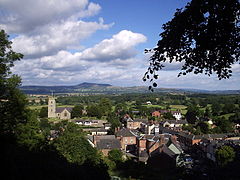Montgomery (Wales)
|
Montgomery Welsh Trefaldwyn |
||
|---|---|---|
| View over Montgomery to the Long Mynd | ||
| Coordinates | 52 ° 34 ′ N , 3 ° 9 ′ W | |
|
|
||
| Residents | 1256 (2001) | |
| administration | ||
| Post town | MONTGOMERY | |
| ZIP code section | SY15 | |
| prefix | 01686 | |
| Part of the country | Wales | |
| Unitary authority | Powys | |
| British Parliament | Montgomeryshire | |
Montgomery (Welsh: Trefaldwyn ) is the former capital of the county of Montgomeryshire and is 22 miles southwest of Shrewsbury on the B 4386 below that of the English King Henry III. Montgomery Castle , built around 1223 , of which only ruins remain.
history
Settlement in the area not far from the River Severn is much older than the aforementioned castle: the remains of several Iron Age hill forts and a large Roman camp (possibly with the name Lavobrinta) lie in the vicinity of Montgomery . The 8th century Offa's Dyke also runs on the outskirts of the city . The name Montgomery is derived from the Norman nobleman Roger de Montgomerie , to whom King William I handed over the land on the Welsh border after the conquest of 1066 . Montgomerie originally came from the Pays d'Auge in Normandy and was entrusted by the king with the task of securing the land for the Norman conquerors both against the Welsh princes and against the dispossessed Anglo-Saxon Thanes . He also built a first wooden castle about a mile south of today's city, now known as the Hen Domen (Old Castle).
In the struggle for Welsh independence in the 13th century, Montgomery, which received city rights in 1227, played an important role several times: For example, the castle of Llywelyn was attacked from Iorwerth in 1228 and again in 1231, although the city was not conquered, although the city was burned down. Another attack made in 1245 Llywelyn's son Dafydd ap Llywelyn . The most important event in the medieval history of the place is the conclusion of the Treaty of Montgomery , in which Llywelyn ap Gruffydd was recognized by the King of England as Prince of Wales . Although the agreements were made in Shrewsbury , they were sealed at a meeting on the banks of the Severn in September 1267 and then celebrated at Montgomery Castle. After the conquest of Wales by King Edward I , the city fortifications were rebuilt as a stone wall from 1279.
After the conquest of Wales, the strategic importance of the castle, which was neglected and was already in 1343, declined. It was renewed again under Roger Mortimer, 2nd Earl of March after 1359 and in the 1530s under King Henry VIII , but the city and castle of Montgomery were no longer of major military importance. In 1541 Montgomery was handed over to the Herbert family , of which the Earls of Powis provide a branch line . During the English Civil War in 1633 there was a battle at the gates of the city, in which the parliamentarians with 3,000 men defeated a royal force about 2,000 men stronger. After the end of the civil war, the castle was finally razed in 1649 . In some cases, materials from the castle were used to build houses in the city.
Today's town center still contains many houses from the second half of the 18th century, although in many cases these are only new facades of much older houses. However, there are also a number of houses in the typical half-timbered style of Montgomeryshire.

